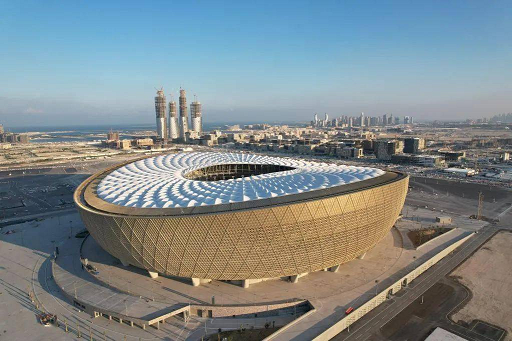By Liu Yao
Chinese elements are seen everywhere at the ongoing 2022 FIFA World Cup in Qatar, from stadium construction and brand marketing to mascot manufacturing, providing strong support for the grand football event.
On the evening of Nov. 22 Beijing time, the China-constructed Lusail Stadium with 92,000 seats finished its World Cup debut, where a match between Argentina led by superstar Lionel Messi and Saudi Arabia took place.
The golden-bowl shaped stadium is located 15 kilometers north of Doha, capital of Qatar. Serving as the largest sporting venue in Qatar and the main venue for the FIFA World Cup Qatar 2022, it will host important matches such as the semi-finals, the final, and the closing ceremony of the World Cup.
China Railway Construction Corporation (International) Limited won the bid to build the centerpiece stadium in 2016. It marked the first time a Chinese enterprise served as a main contractor to build a FIFA World Cup pitch.
The stadium is also the largest and most advanced one among professional football stadiums built by Chinese enterprises overseas.
Boasting the world’s widest-spanning double membrane tensile structure, the Lusail Stadium has a roof cable span of 278 meters. As a green venue, it adopts a double-façade structure to ensure thermal insulation in the scorching days of Qatar.
To make the football pitch and the spectator area cooler and more comfortable, independent cooling stations were built outside the stadium, sending cool breezes into the stadium through the ventilation ducts under the spectator seats.
Hassan Al Thawadi, secretary general of the 2022 Qatar World Cup Supreme Committee for Delivery and Legacy, said the complex structure proves the great skills and service capability of Chinese enterprises, adding that those who watch the games in the venue should be grateful to Chinese engineers and constructors.
During the World Cup, Chinese new energy buses are offering shuttle services for spectators, officials and journalists between stadiums and hotels. It is reported that Qatar has imported 1,500 buses from China, including 888 electric ones to meet the transportation demand during the World Cup.
It marked the first time for a major global sports event to use Chinese new energy buses in such large quantities, as well as the first time that pure electric buses make up the majority of World Cup fleets.
In 2020, Chinese manufacturer Yutong was selected to provide service vehicles for the Qatar World Cup. The company equipped its buses with a device that shields the motors from sand and mud, employed liquid-cooling power batteries and adopted an intelligent temperature control algorithm for the air conditioners in the buses.
These intelligent and green vehicles are welcomed by local people and will keep running in Qatar as an important part of the country’s public transport system after the World Cup.
In a desert 80 kilometers west of Doha, there is a vast photovoltaic (PV) power station with a total area equal to 1,400 standard football pitches.
Built by the PowerChina Guizhou Engineering Co., Ltd., the 800MW Al Kharsaah Solar Power Plant has over 2 million PV panels that are able to generate 1.8 billion kilowatt hours of clean electricity for Qatar each year. It can supply around 300,000 local households and reduce 900,000 tons of CO2 emissions on an annual basis.
During the construction of the power plant, the Chinese company tailored detailed relocation plans for local animals and plants such as lizards and snakes, in an effort to minimize the impacts on local ecology.
More Chinese elements abound both on and off the field in Qatar. The appearance of referees Ma Ning, Shi Xiang and Cao Yi marks the first time in the recent 20 years for Chinese referees to judge World Cup games.
Chinese companies have put up nearly $1.4 billion in sponsorship deals for the world cup, outdoing the spending by U.S. brands and becoming the top among all countries.
According to the estimation by the sports equipment society of China’s Yiwu, the world’s largest wholesale market in small commodities, 70 percent of World Cup peripheral products were from Yiwu.
Chinese giant pandas Jing Jing and Si Hai, which were sent to Qatar in October this year, made their first public appearance in the country just a few days ahead of the opening of the World Cup. They carry the wishes of the Chinese people for the grand event.












